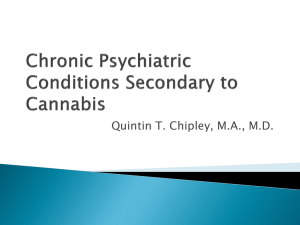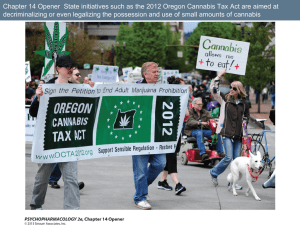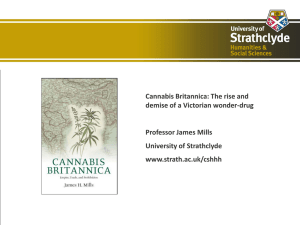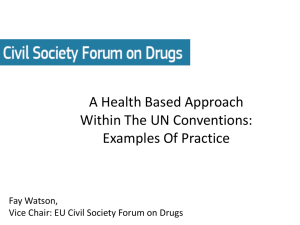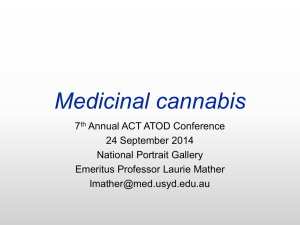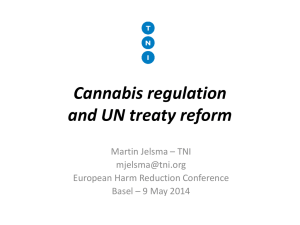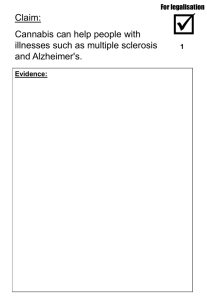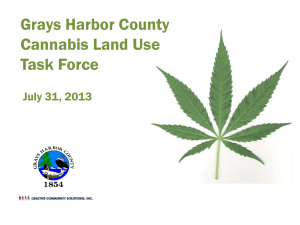Malcolm Bruce Consultant Psychiatrist in
advertisement
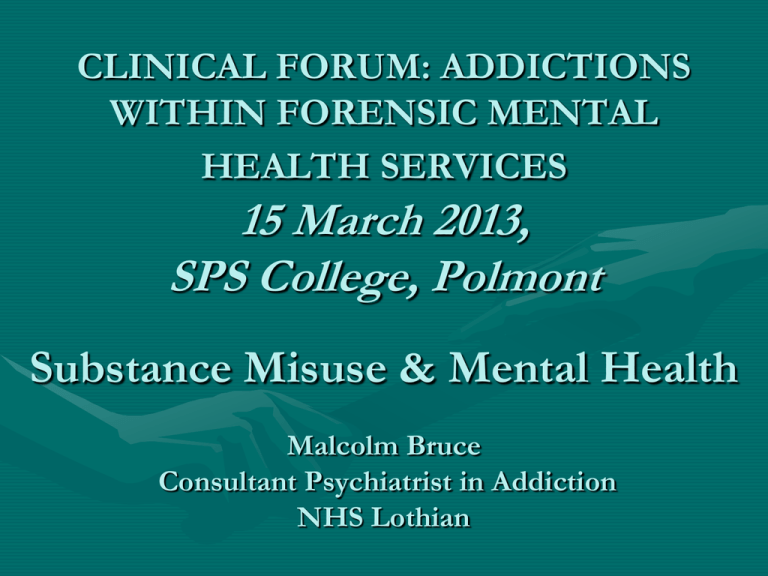
CLINICAL FORUM: ADDICTIONS WITHIN FORENSIC MENTAL HEALTH SERVICES 15 March 2013, SPS College, Polmont Substance Misuse & Mental Health Malcolm Bruce Consultant Psychiatrist in Addiction NHS Lothian Structure of presentation 1. Some data relevant to Forensic Psychiatry 2. What's the background of Drugs Induced Psychosis 3. What’s new in Drugs 4. What’s new in Psychosis 5. What’s new in co-morbidity 6. Summary with my view of MWC focus A SERVICE EVALUATION OF THE MANAGEMENT AND EDUCATION OF DRUG DEPENDENT INPATIENTS IN SCOTTISH FORENSIC PSYCHIATRY SETTINGS. • AUTHORS: Dr Michelle McGlen, ST4 Forensic Psychiatry, South East Scotland Deanery. • Dr Fionnbar Lenihan, Consultant Forensic Psychiatrist, Orchard Clinic, Royal Edinburgh Hospital, Edinburgh Issues from MWC & WHO • Lack of access to specialist drug services • Lack of education regarding loss of tolerance and dangers of poly-substance misuse (ref: high drug related mortality following release) • Variable practice regarding approaches to managing drug dependent patients on admission to facilities (e.g., enforced abstinence) Online Survey Forensic Settings • Focussing on drug dependent patients – Assessment – Management – Education • Lead clinicians at all eight units – 100% reply Results Lack of access to SM team V Agree*2 Agree*3 DK*2 Disagree*1 Identify DWS H/E/I all Scales*3 Urine*5 Oral*2 Ideal model joint*7 only forensic*1 Access to SM team yes*6 no*2 Use SM team often*2 occ*3 rare*3 Management Detox*4 ISQ*1 DK*1 Nothing*2 Education 1:1 *7 Group*6 MI*4 Naloxone*3 Background of Drug induced psychosis… • Hallucinogens – designed onset effect, LSD etc., • Stimulants – onset effect, dose related side effect, cocaine etc., • Sedatives incl alcohol – offset effect, withdrawal states, with long term neuro-cognitive damage. • Cannabis – onset effect, dose effect, THC content changes • Drug subculture & overlap with disadvantaged groups (Severe & Enduring Mental Illness) Risks to human health • Direct Cannabis effect (not a single drug) – Cannabinoid receptors • Immediate – desired effect / intoxication • Intermediate – tolerance / dependence / withdrawal – Other effects • Delayed – carcinogenesis (what part of drug mix?) • Induce psychotic illness? (what part of drug mix? Esp. cannabidiol :THC ratio) • Indirect – E.g., choice of route and technique – Established illness (schizophrenia) - dealing with cannabis use (including dependence) is now a major element in the clinical management of many young men with established psychotic illnesses. Some of the evidence... • The number of patients admitted to hospital with a diagnosis of acute cannabis intoxication in England has remained stable (at between 107 and 140 per year) over the 5 years 1995–2003 • Newcombe RD. (2004) Does cannabis cause psychosis? A study of trends in cannabis use and psychosis in England, 1995–2003. Evidence to the Advisory Council on the Misuse of Drugs. Advisory Council Misuse Drugs 2002 2005 –”increase in the potency of cannabis products currently available....suggesting a causal link between cannabis use and the development of mental health problems” The Council does not advise the reclassification of cannabis products 2008 – “review the classification of cannabis in the light of real public concern about the potential mental health effects of cannabis use and, in particular, the use of stronger strains of the drug.” The Council does not advise the reclassification of cannabis products Mean THC content (%) of cannabis products Median THC and CBD content (%) in material seized in 2005 What’s new in Drugs … • New substances (Early Warning Systems, European Monitoring Centre for Drugs and Drug Addiction) – 2009 – 24 – 2010 - 41 – 2011 – 49 – 2012 expected the total 60 • Online sites selling drugs – 2010 – 314 – 2011 - 690 • • • • Annihilation (3g) Availability: IN STOCK £28.19 IN STOCK • Designed for maximum effect, the improved blend burns a new herbal incense atmosphere into the room. Out of the box thought combined with elation. Annihilation is best shared, best experienced as a singular calm with others. Nights in were never meant to be like this. A pwoerful legal incense fixer upper to an otherwise dull night, burn Annihilation and set a fire to your night. • They consume you. You don't consume them. “Legal High” • Advertised as plant food or research chemicals, and often labelled ‘not for human consumption’ • Synthetic cannabinoids sprayed onto a plant based mix (that does not contain tobacco or cannabis) for the purposes of achieving intoxication from smoking. • lack of regulation over their production, distribution and use ACMD 2009 • Experience in Germany that suggests that should one of the cannabinoids be controlled, manufacturers move to adding a chemically different, yet functionally similar, synthetic cannabinoid in the ‘Spice’ mix. Due to the number of variations, it is highly likely that specific legislation would always run some way behind the availability of a legal mix on the street. Cannabidiol can directly activate 5-HT1A receptors… …but only with rather low potency OH Cannabidiol HO Cannabidiol • Cannabidiol (CBD) in animals, has been shown to have effects similar to antipsychotic drugs through an as yet undetermined mechanism • A survey of ketamine users, who also used cannabis, found that those who had both CBD and THC present in hair samples exhibited a lower rating of psychosis-like symptoms than those in whom only THC was found Morgan CJA, Curran HV (2008) Effects of cannabidiol on schizophrenialike symptoms in cannabis users. B J Psych 192: 306–307. Cannabis & specific subtypes • Cannabis produces its effects on the human brain through interactions between THC and specific proteins on the surface of cells known as cannabinoid receptors. Other psychoactive components of cannabis, especially cannabidiol, interact with other receptors in the brain. Different preparations of cannabis have different proportions of THC and other psychoactive constituents; the consequences of using cannabis may, therefore, vary depending on the relative proportions of the psychoactive substances that are present. ACMD 2012 • For those drug groups which are controlled in the UK by generic legislation, such as the synthetic cannabinoids, gaps in the generic controls are being exploited which permit “designer” versions (specifically formulated to have certain effects and avoid legislation) to be offered • Home Office Forensic Early Warning System (FEWS) in July 2012 included results from a test purchasing exercise showing the presence of uncontrolled synthetic cannabinoids, such as AM2201, RCS-4 and UR-144, in substances on sale via the internet. Modifications of chemical structure noted since the 2009 report include: • Substitution with halogen atoms on the side chain attached to the indole nitrogen atom (for example AM 694, AM 2201). It appears that such modifications can enhance potency. The onset of psychoactive effects of AM2201 are cited as occurring rapidly and may last for up to 3 hours (ReDNET, 2012). • Modification of the indole nitrogen substitution into a methylpiperidin-2-yl structure (AM 1220, AM 2233). • Use of a benzoylindole core structure (AM-694, RCS-4). This structure was not included in the 2009 generic controls. • Replacement of the benzoyl/naphthoyl structure by an adamantoyl group (AB-001, AM-1248). • Replacement of the benzoyl/naphthoyl structure by a tetramethylcyclopropylcarbonyl group (UR-144, AB-034). Worst case scenario......? • 1982 - Patients arrived at San Francisco area emergency rooms after using a synthetic analogue of heroin (to get around the law)(MPPP contaminated with MPTP – made originally by a 23year-old chemistry graduate student). Fully conscious but unable to move or speak, they were soon diagnosed as having advanced irreversible Parkinson's disease. Government Response • November 2011, the UK government (as part of the Police Reform and Social Responsibility Bill) introduced an amendment to Schedule 17 of the Misuse of Drugs Act 1971 that permits any substance not already classified by the Act that is ‘being, or is likely to be, misused’ and whose misuse ‘is having, or is capable of having harmful effects’ to be placed in a temporary class drug order for a 12 month period. • At the end of this 12-month period, the Advisory Council on the Misuse of Drugs (ACMD) is required to produce a report recommending permanent classification Where are services responding.. • Addiction Services – NHS, set up to deal with addiction to alcohol, heroin, benzodiazepines and crack cocaine – Crew 2000 • A&E • MHAS/IHTT • I/P Psychiatric Service - Drugs: a medical matter • A moral/spiritual judgemental stand is not acceptable for a health problem. • Patient’s first • Raising profile of detection • Range of responses by all doctors from harm reduction – to referral to specialist services • A challenge to nihilistic views on interventions, but accepting of an often chronic relapsing condition. What's new in Psychosis • First Episode Psychosis (FEP) • Duration of Untreated Psychosis (DUP) • Good outcome at 3-5 years in FEP related to short DUP How should we approach the diagnosis and assessment of FEP? Online RCPsych CPD • First-episode psychosis: – Part 1 – assessment, diagnosis and rationale – Part 2 – treatment approaches and service delivery Dr Andrew Thompson, Dr Rick Fraser and Dr Richard Whale Diagnostically, DSM-IV identifies psychoses • • • • • • • • Schizophrenia Schizoaffective disorder Delusional disorder Brief psychotic disorder Shared psychotic disorder Psychotic disorder due to a medical condition Substance-induced psychotic disorder Psychosis not otherwise specified (NOS). • Such diagnoses, however, require clear symptom profiles and durations that are difficult to elucidate in the first acute presentation. What’s new in co-morbidity? NICE guideline 2011 Raise profile of detection – ask… • Substance(s) used • Quantity, frequency and pattern • Route of administration • Duration of current level of use • Evidence of Dependence – Carving, Loss of control, tolerance, withdrawal, use to avoid withdrawal, harm health/relationships etc., • Consent for corroborative history Respectful, trusting, non-judgemental • Do not exclude from either – Mental Health Services – Drug Services • Various models of delivery of care – Joint working • Parallel services with good communication (+/- CPA) • Joint clinics – Specialist Co-morbidity clinics • Assessment of vulnerable adult & children I/P Services • Promoting a therapeutic environment free from drugs and alcohol – – – – – search procedures, visiting arrangements, planning and reviewing leave, drug and alcohol testing, disposal of legal and illicit substances In patient Px options... • Appropriate use of a brief medication-free observation period when at all possible (24–48 hours) • Use of benzodiazepines both during this period and as an appropriate means of treating acute agitation or disturbance • Judicious use of short-acting rapid tranquilisation if necessary. DRUG TREATMENT of ACUTE BEHAVIOURAL DISTURBANCE in GENERAL ADULT (18 – 65yrs) PSYCHIATRIC IN-PATIENTS • Preventative skilled management (e.g. de-escalation techniques) is obviously preferable to the use of medication. Medication prescribed in an emergency should be reviewed at least daily to prevent subsequent inappropriate escalation of dose • Rationale for Choice of Regimens for Algorithm • Haloperidol and lorazepam is the treatment choice in acute behavioural disturbance and must be considered first line for all patients. • This combination of haloperidol and a benzodiazepine is desirable to avoid very high antipsychotic doses when the immediate aim is sedation. • Olanzapine is the second treatment choice and may only be considered for: – patients who have had severe dystonic reactions to haloperidol previously – patients with less extreme agitation who are refusing oral therapy but who are showing escalating levels of hostility – IM Olanzapine must not be administered with a benzodiazepine. Mental Welfare Commission (MWC) (1) • Concerns regarding use/misuse MHA in comorbidity cases • Support / promote NICE guide – Respectful, trusting, non-judgemental relationship – Routinely ask about drug/alcohol use, testing and corroboration with consent – Do not exclude/discharge from services solely due to substance use – Discharge with a Care Plan +/- CPA MWC (2) - Using MHA • Drug aetiology does not exclude use • Symptoms may not completely subsided, and even if they appear to have, a longer period of assessment may be needed especially in novel drugs • Drug and alcohol services need to be more assertive in helping people to engage • To help patients make an informed choice about lifestyle and drug use MWC report Mr F 2009 Effective care and treatment in dual diagnosis of mental illness and alcohol misuse • Stigma CSA/PTSD/PD/Addiction (ADS) – Delay in diagnosis of Psychotic illness • Poor engagement – discharge v out reach • Poor outcome – Homicide 2ndry to command hallucinations • Service model strengths – DDT v CMHT/SMS – Change RMO I/P & O/P • Required – Shared Care Plans v CPA – Involvement none NHS – Risk assessment with reviews built in MWC report Ms Z 2010 Effective care and treatment in dual diagnosis of mental illness and alcohol misuse • Diagnostic uncertainty – Schizophrenia, schizoaffective disorder, alcohol problems, ARBD, personality factors and social aetiology • Crisis management with no care plan • Unplanned discharge with no care plan • Autonomy v control by the use of MHA • Ongoing responsibility for psychiatric care – leadership required • No joint working CMHT & Addiction service, no outreach • CPA again promoted • Response to drinking as I/P Summary – Drug Induced Psychosis • • • • Address our stigma to substance use Raise our detection of substance use Challenge our nihilism to I/P substance use Acknowledge uncertainty in management of FEP in context of substance use, and the skills inherent in Consultant Psychiatrist. Promote Medical Leadership. • In high risk cases – care plans, assertive outreach and 2nd opinions +/- MHA CTO are required
